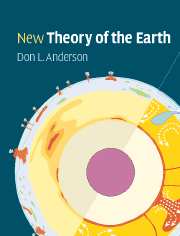Book contents
- Frontmatter
- Contents
- Preface and Philosophy
- Abbreviations and acronyms
- Part I Planetary perspective
- Part II Earth: the dynamic planet
- Part III Radial and lateral structure
- Chapter 8 Let's take it from the top: the crust and upper mantle
- Chapter 9 A laminated lumpy mantle
- Chapter 10 The bowels of the Earth
- Chapter 11 Geotomography: heterogeneity of the mantle
- Part IV Sampling the Earth
- Part V Mineral physics
- Part VI Origin and evolution of the layers and blobs
- Part VII Energetics
- References and notes
- Appendix
- Index
Chapter 10 - The bowels of the Earth
Published online by Cambridge University Press: 05 June 2012
- Frontmatter
- Contents
- Preface and Philosophy
- Abbreviations and acronyms
- Part I Planetary perspective
- Part II Earth: the dynamic planet
- Part III Radial and lateral structure
- Chapter 8 Let's take it from the top: the crust and upper mantle
- Chapter 9 A laminated lumpy mantle
- Chapter 10 The bowels of the Earth
- Chapter 11 Geotomography: heterogeneity of the mantle
- Part IV Sampling the Earth
- Part V Mineral physics
- Part VI Origin and evolution of the layers and blobs
- Part VII Energetics
- References and notes
- Appendix
- Index
Summary
The lower mantle
I must be getting somewhere near the centre of the earth. Let me see: that would be four thousand miles down. I think-
AliceThe traditional lower mantle starts near 800–1000 km where the radial gradient of the seismic velocities becomes small and smooth. This is Bullen's Region D. The 1000-km depth region appears to be a fundamental geodynamic interface, perhaps a major-element chemical and a viscosity interface. Some authors take the lower mantle to start just below the major mantle discontinuity near 650 km. The depth of this discontinuity varies, perhaps by as much as 40 km and is variously referred to as the ‘660 km discontinuity’ or ‘670 km discontinuity’; the average depth is 650 km. In detailed Earth models there is a region of high velocity gradient for another 50–100 km below the discontinuity. This is probably due to phase changes, but it could represent a chemical gradient. Plate reconstructions show that past subduction zones correlate with high-velocity regions of the mantle near 800–1000 km depth. The ‘lower mantle proper’ therefore does not start until a depth well below the 650 km boundary, more in agreement with the classical definition. Below this depth the lower mantle is relatively homogenous until about 300 km above the core-mantle boundary. If there are chemical discontinuities in the mantle the boundaries will not be at fixed depths.
- Type
- Chapter
- Information
- New Theory of the Earth , pp. 116 - 123Publisher: Cambridge University PressPrint publication year: 2007



